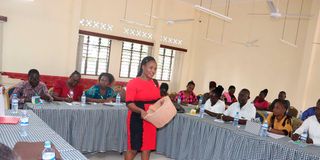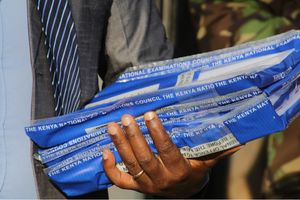Kilifi transitions to eco-friendly cooking energy one stove at a time

Jemimah Mwakireti of Mtwapa Energy Centre explains to community leaders how ‘kuni mbili’ stove works.
What you need to know:
- In general, the county’s main source of cooking energy, particularly within rural communities, is largely firewood burned at the centre of the traditional three stones.
It is mid-July and a team of 25 women and youths selected from all seven sub -counties of Kilifi County are gathered at Mtwapa Energy Centre on a three-day mission to learn how to mould a unique cooking stove known as ‘kuni mbili’, which uses only two pieces of firewood at a time.
In general, the county’s main source of cooking energy, particularly within rural communities, is largely firewood burned at the centre of the traditional three stones, from which most of the heat escapes into the open air.
“Our target is to train residents on how to minimise the use of biomass used for cooking as much as possible, while at the same time ensuring that there is efficiency of cooking as a way of protecting the environment and reducing risks associated with excess smoke at household levels,” said Mohamed Shuqry, the coordinator at the Mtwapa Energy Centre.
The centre is one of the facilities that were established under the Rural Electrification and Energy Corporation to promote environment-friendly energy development and dissemination at county levels across the country.
Shuqry notes that kuni mbili stove is designed with a lining made of fire-treated clay. “The lining keeps the heat on target, which leads to minimum use of biomass, but maximum and efficient utilisation of the heat,” he said. The initiative is in line with the Kilifi County Integrated Development Plan, which seeks to promote energy efficiency by promoting the use of clean cook stoves and energy saving jikos in institutions and at household level.

Jemimah Mwakireti displays fire-treated linings for kuni mbili stoves
The programme to build capacities and create awareness of environment friendly cooking solutions in Kilifi is driven by collaboration between the county government, the Clean Cooking Association of Kenya (CCAK), World Wide Fund (WWF) and community based organisations under the Voices for Just Climate Action.
According to Philomena Mitalo, the programme officer at CCAK, uptake of the improved stoves, most of which are imported, has been very low because of the high taxes. “The costs of these stoves outweigh benefits, thereby impeding national climate and sustainable development goals,” she told the Climate Action.
CCAK has been on the forefront trying to influence policy and fiscal environment in regards to import duty and Value Added Tax that is affecting access and adoption to clean cooking solutions especially among the rural poor.
To mitigate this, Kilifi County has installed briquette making machines in each of the seven sub-counties for local communities to use for briquette making instead of relying on charcoal and wood fuel.
Studies have shown that briquettes, which are compressed blocks of charcoal dust or other combustible biomass materials mixed with clay, have a higher thermal calorific value and lower ash content compared to charcoal. Alice Mwiza from Guruguru village in Kaloleni said briquette making has now become one of her sources of income.
“I have taken briquette making as a business, which is now becoming very popular among the local households,” said Mwiza, one of the community leaders who had come to learn how to mould kuni mbili cook stove.
Excessive use of biomass use as cooking energy has been linked to forest degradation, deforestation, decline in biodiversity, soil degradation, indoor air pollution and emission of greenhouse gasses.
According to Mitalo, well designed cook stoves have the ability to significantly reduce smoke due to the efficient use of biomass and high combustion rate, thereby reducing indoor air pollution.
“We have many other cleaner sources of energy, but for the sake of just transition, we cannot move straight from the traditional three stone fireplace to the most sophisticated cooking solution. We have to start with what the communities identify with, which in this case is firewood,” she said.
The initiative for environment friendly cooking solutions targets to reach at least 10,000 households in Kilifi County in the next four years.




